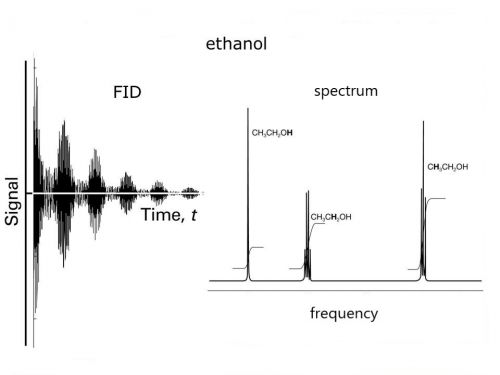Difference between revisions of "Fourier Transform"
| (5 intermediate revisions by the same user not shown) | |||
| Line 1: | Line 1: | ||
Fourier Transform does mathematically what our ears do physically: resolve a signal into component frequencies. FT is a method to determine the simple wave components of a mixed wave. The method is theoretically based on calculus, but is actually carried out computationally using numerical analysis. | Fourier Transform does mathematically what our ears do physically: resolve a signal into component frequencies. FT is a method to determine the simple wave components of a mixed wave. The method is theoretically based on calculus, but is actually carried out computationally using numerical analysis. | ||
| − | The signal output from an NMR instrument is called a Free Induction Decay (FID) and looks like | + | The signal output from an NMR instrument is called a Free Induction Decay (FID) and looks like the image on the left, which is intensity of the signal versus time. A fourier transform algorithm is applied to the signal which converts it to intensity versus frequency and looks like the image on the right: |
| − | + | [[File:ethanol_fid_and_spectrum_modified.jpg|500px]] | |
| − | [ | + | A good way to see the method in action is to use excel and a simple dataset of times and intensities. A description of how to use excel to do FT is given [http://online.sfsu.edu/jtai/downloads/ENGR%20302/Excel.FFT.pdf here], but I will summarize it in case this link disappears: |
Latest revision as of 13:44, 15 April 2021
Fourier Transform does mathematically what our ears do physically: resolve a signal into component frequencies. FT is a method to determine the simple wave components of a mixed wave. The method is theoretically based on calculus, but is actually carried out computationally using numerical analysis.
The signal output from an NMR instrument is called a Free Induction Decay (FID) and looks like the image on the left, which is intensity of the signal versus time. A fourier transform algorithm is applied to the signal which converts it to intensity versus frequency and looks like the image on the right:
A good way to see the method in action is to use excel and a simple dataset of times and intensities. A description of how to use excel to do FT is given here, but I will summarize it in case this link disappears:
